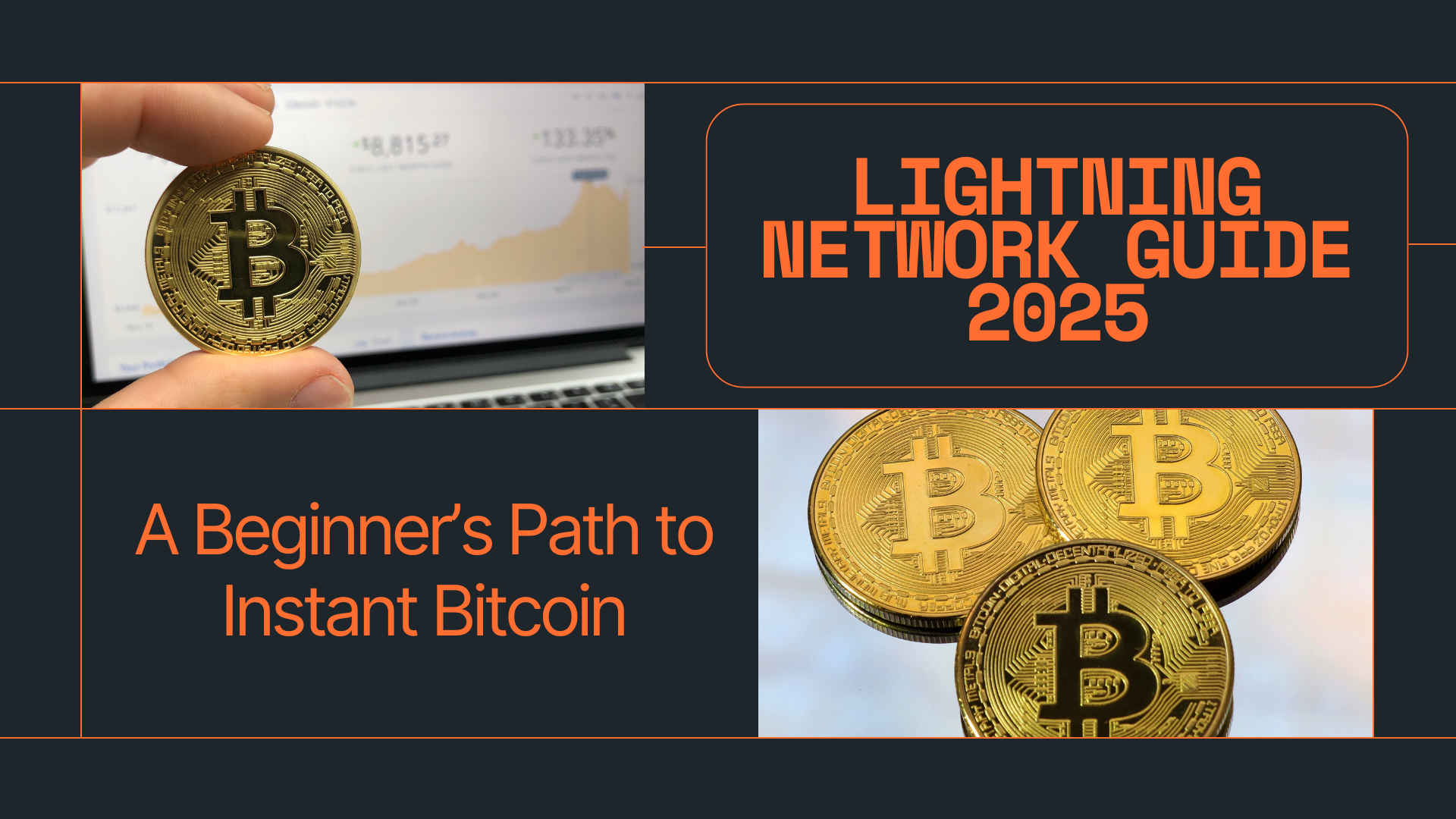
Bitcoin is secure and decentralised, but its base layer confirms only about seven transactions per second. Enter the Lightning Network (LN)—a second-layer protocol that settles payments off-chain and records only opening and closing transactions on Bitcoin itself. In early 2025 public capacity climbed above 5,000 BTC—worth roughly half a billion dollars—marking a 384 % increase since 2020 and signalling that Lightning has left the lab and entered commerce. This guide explains how it works, why it matters, and how you can start moving sats in milliseconds for less than a cent.
What Problem Does Lightning Solve?
- Scalability – Off-chain channels aggregate thousands of transfers into two on-chain movements (open/close), relieving Bitcoin’s mempool.
- Cost – Average Lightning fees hover below US $0.01, versus US $3–5 on busy days for on-chain transactions.
- Speed – Payments settle in under a second, enabling tap-to-pay at cafés or machine-to-machine micro-transactions.
How Does the Lightning Network Work?
Payment Channels
Two parties—say, Alice and Bob—commit a funding transaction to Bitcoin, creating a 2-of-2 multisig address. This locks coins into a channel. They can then update the balance sheet privately as often as they like: Alice pays Bob coffee money, Bob tips Alice, all without touching the blockchain.
Routing Through Hops
If Alice wants to pay Charlie without a direct channel, the protocol finds a path—Alice → Bob → Charlie. Nodes earn a tiny routing fee for forwarding liquidity, incentivising a global mesh. The process uses Hashed Timelock Contracts (HTLCs) to guarantee atomic settlement: either every hop succeeds or the money snaps back to the sender.
Onion Privacy
Like Tor, Lightning wraps each hop in encrypted layers, so intermediate nodes know only the previous and next peer. No single router sees the full path, protecting user privacy.
Key Metrics in 2025
| Metric | January 2025 | July 2025 | Source |
| Public capacity (BTC) | 5,358 BTC | ~5,400 BTC | Fidelity Digital Assets, Aurpay |
| Nodes (public) | ≈ 19,000 | ≈ 20,500 | CoinGate blog |
| Estimated users | 600 M+ (incl. Cash App, Nubank) | 650 M+ | Breez 2025 report |
Real-World Applications
Retail Payments
Block, Inc. will let four million Square merchants accept Bitcoin via Lightning in H2 2025. Customers scan a QR code; settlement finalises instantly, and merchants avoid 3 % card fees.
Streaming Money
Podcasting 2.0 apps like Fountain stream sats per minute to hosts as listeners tune in, turning attention into revenue without ads.
Stablecoins on Lightning
Lightning Labs’ Taproot Assets v0.6 lets anyone mint and move stablecoins over Lightning rails, creating a multi-asset network anchored in Bitcoin. Tether has already committed to issue USDT using the standard.
Remittances
Strike’s Send Globally feature routes dollars to naira or peso via Lightning, undercutting Western Union and settling in seconds.
Gaming & IoT
Every time a gamer scores a kill or a sensor reports data, micro-rewards flow over LN, unlocking new machine-to-machine business models.
Getting Started: Wallets and Nodes
| Type | Example | Best For |
| Custodial Wallet | Wallet of Satoshi, Blink | Instant onboarding; sprint trials |
| Non-Custodial Mobile | Phoenix, Breez, Muun | Everyday spending with self-custody |
| Desktop Node | Core Lightning, LND | Power users, routing fees |
| Plug-and-Play Box | Umbrel, Start9 | Hobbyists running a full node + LN |
How to Open Your First Channel
- Install a non-custodial wallet (Phoenix).
- Buy BTC on an exchange and withdraw on-chain to the wallet.
- The wallet auto-opens a channel for a small fee—done. Now you can send or receive sats.
Advanced users can open channels manually: choose a well-connected node (Terminal Web ranks nodes), fund an on-chain transaction, and set routing fees.
Fees Explained
Lightning fees = base fee (sats) + proportional fee (ppm). Example: 1 sat base + 50 ppm on a 100,000 sat payment costs 1 sat + 5 sats = 6 sats total (~US $0.002). Wallets calculate this automatically.
Security and Risks
- Hot Wallet Exposure – Mobile LN wallets keep private keys online; use small balances for daily spend.
- Channel Jams – Too little inbound liquidity means you can send but not receive; tools like Lightning Loop or Boltz swap on-chain BTC for inbound capacity.
- Protocol Bugs – Early 2024 saw a CLN HTLC bug; keep software updated to the latest stable release.
- Regulatory Cloud – Some jurisdictions may treat routing nodes as money transmitters, though no major action has occurred to date.
The Road Ahead
- Multi-Asset Lightning – Taproot Assets brings USD stablecoins, company shares and loyalty points onto LN.
- PTLC Upgrade – Point-Time Locked Contracts will replace HTLCs, improving privacy and atomic swaps.
- AMP Adoption – Atomic Multi-Path payments already split large invoices; broader wallet support will reduce failed payments.
- Enterprise APIs – Visa’s 2025 investor deck lists Lightning under “real-time A2A networks,” hinting at future integration.
Action Plan for New Users
- Download a custodial wallet (Wallet of Satoshi) and receive a 1,000-sat tip from a friend.
- Order a coffee at a Lightning-enabled café or buy a gift card via Bitrefill.
- Upgrade to a non-custodial app (Phoenix) and move your sats.
- Experiment with swaps: loop out some sats to an exchange wallet and back.
- Read guides from Lightning Labs and Bitcoin Magazine to deepen knowledge.
Conclusion
The Lightning Network has evolved from a developer experiment into a payment rail used by Cash App, Square, major exchanges and hundreds of independent merchants. Public capacity topping 5,000 BTC, the rollout of stablecoins via Taproot Assets, and mainstream merchant integrations signal that Bitcoin’s scalability story is finally matching its store-of-value narrative. Whether you’re a shopper tired of 3 % card fees, a freelancer receiving cross-border tips, or an entrepreneur building IoT micro-services, Lightning offers a fast, inexpensive gateway to the Bitcoin economy. Download a wallet, fund a channel, and join the network that’s turning sats into everyday money.